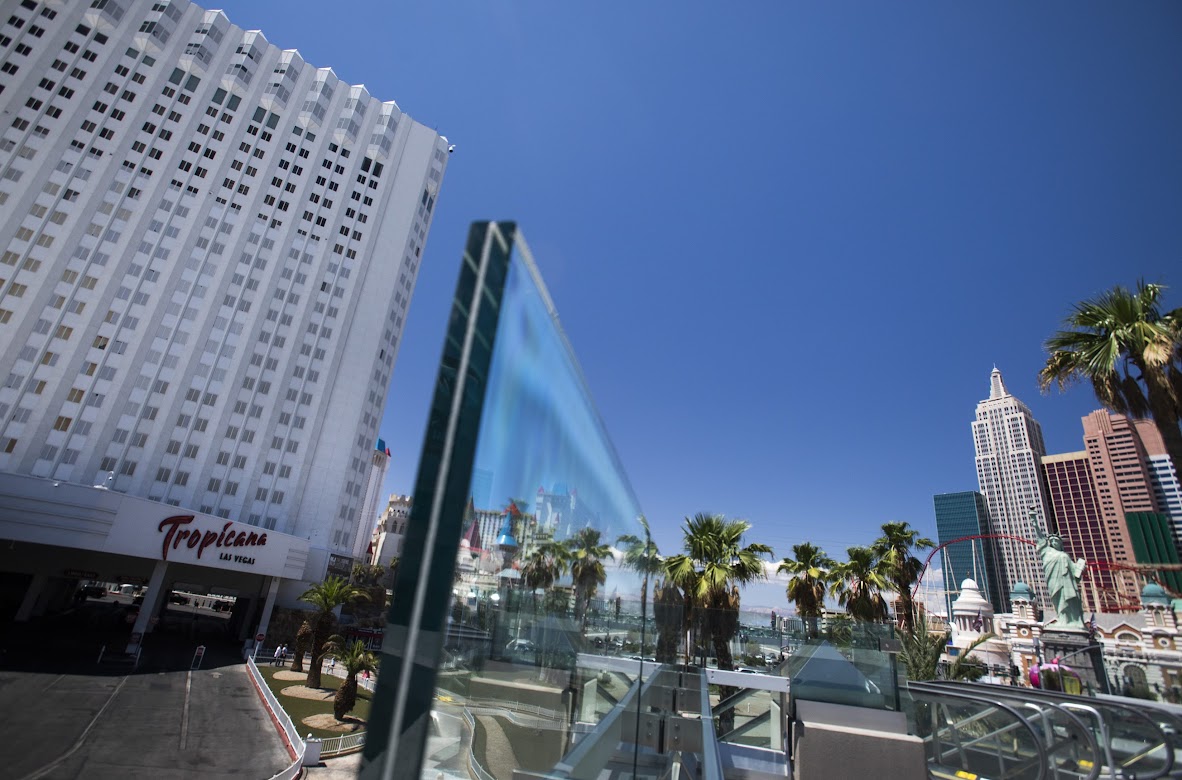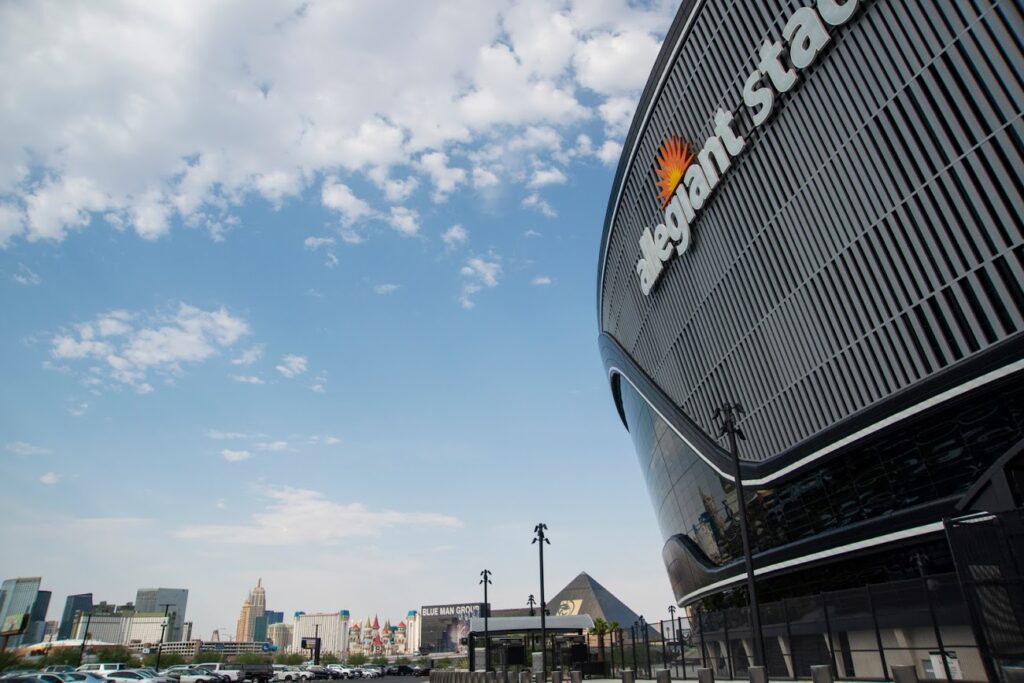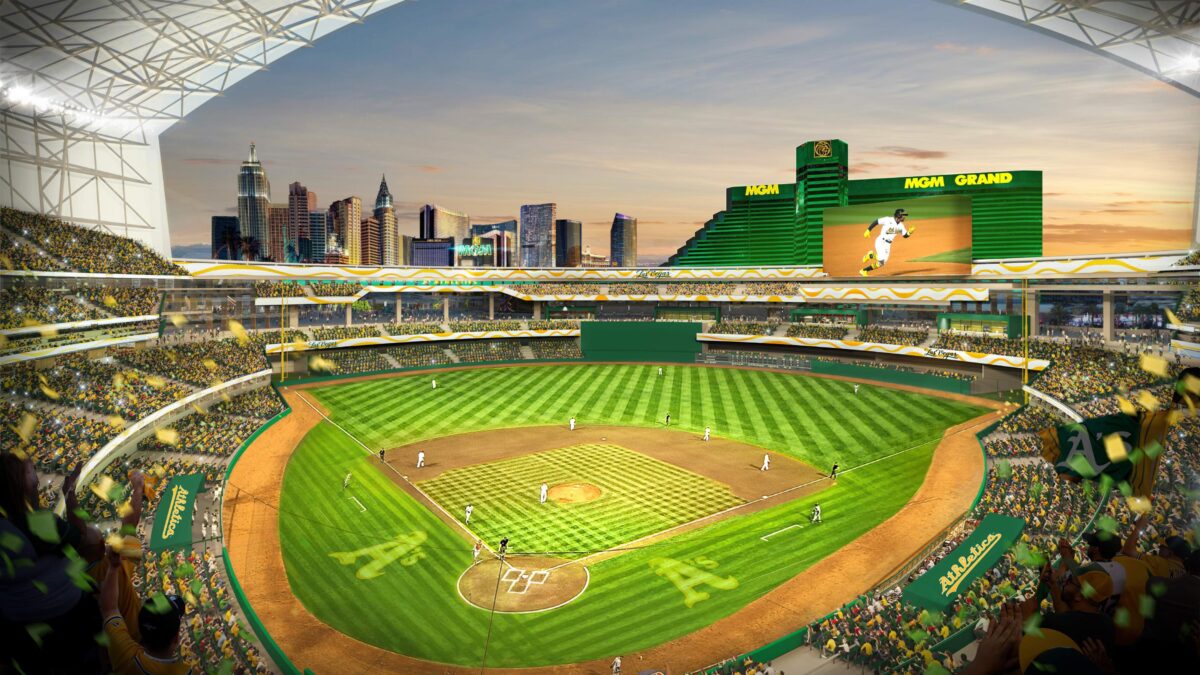Casino industry stands to benefit from A’s move to Vegas, analysts say

If Wall Street is judging the Strip’s winners and losers in the A’s proposed $1.5 billion stadium deal to bring the franchise to Las Vegas, MGM Resorts International clearly hit a royal flush.
Unlike the 2016 agreement that hiked hotel room taxes to help fund a substantial portion of construction costs for the $1.9 billion Allegiant Stadium, MGM Resorts isn’t responsible for any of the proposed stadium’s public financing.
Instead, the company stands to benefit primarily because of proximity to the planned 30,000-seat retractable roof ballpark.
Five of the company’s Strip megaresorts totaling more than 13,000 rooms — MGM Grand Las Vegas, New York-New York, Excalibur, Luxor and Mandalay Bay — are directly across from the Tropicana site along the Strip and Tropicana Boulevard. Aria and Park MGM provide another 7,000 rooms just a few blocks away.
Pedestrian overpasses connect Strip visitors to the street corners at the Strip and Tropicana intersection in all directions.
Stifel Financial gaming analyst Steven Wieczynski had previously scheduled meetings with MGM Resorts’ top brass at the same time the news of the A’s pivot to the Tropicana site broke. The discussions immediately focused on several ways MGM could benefit from the development.
“The MGM Grand has a large-scale parking garage that is currently under-utilized which could generate significant revenues on Major League Baseball game days given attendance is expected to be comprised of mostly local residents,” Wieczynski told investors in a research note.
He suggested MGM might consider redeveloping the Excalibur, which sits at the southwest corner across from the Tropicana, because of potential “outsized returns” in a few years once the stadium is completed.
In a presentation to lawmakers last week concerning SB509 and its request for up to $380 million in public money, Applied Analysis founder Jeremy Aguero estimated stadium events would attract 2.6 million visitors annually with 762,000 — 30 percent — coming from out of town.
Of those visitors to Las Vegas, Aguero projected the stadium would attract 405,000 incremental visitors — travelers who would not have come to Las Vegas if not for a special event.
He cited figures for Allegiant Stadium, where in the 2016 special session where the public funding bill was adopted, Applied Analysis projected 818,000 annual out-of-town visitors and 451,000 incremental visitors for events at the 65,000-seat facility.
In 2022, events at the stadium attracted 973,000 out of town visitors, 19 percent higher than projections and 871,000 incremental visitors, 93 percent above the predictions.
Aguero said in an interview prior to the hearing that Applied Analysis used information based on the region, and data gathered from stadiums and other arenas within the area to generate the analysis and estimates presented to lawmakers.
On Tuesday, a day after the hearing, Nevada Resort Association President Virginia Valentine and the trade group threw support behind SB509, saying the stadium would enhance the Strip’s “iconic skyline” and expand Las Vegas’ growing reputation as a sports destination while offering visitors another reason to travel to the city or extend their stay.
“As we’ve seen with other professional sports leagues in Las Vegas, the home games drive increased visitation and visitor spending as fans want to experience the destination’s newest attraction,” she said in a statement.
During testimony last week, State Treasurer Zach Conine said all tax revenues generated within the stadium’s 9-acre footprint — including sales, payroll and other taxes — would be used to pay the principal and interest for $120 million in bonds backed by Clark County.
Conine estimated the taxes remitted toward bond payments would be approximately $38 million during construction because of the sales tax from materials. The figure would drop to $10 million once the stadium opens, growing to about $22 million a year over the full term of the bonds.
Aguerro told The Nevada Independent the language throughout SB509 mirrors the Raiders deal. However, he said the financing portion of the bill relies on bonding and transferable tax credits and is completely different from the room taxes that were used to fund the construction of Allegiant Stadium.

In 2016, former MGM Resorts Chairman and CEO Jim Murren, along with then-Wynn Resorts Chairman Steve Wynn and former Caesars Entertainment Executive Vice President Jan Jones Blackhurst told lawmakers in the special session their companies were willing to accept the 0.88 percent room tax increase to fund the $750 million in public money requested for the football stadium.
The only public comment MGM Resorts CEO Bill Hornbuckle has made concerning the baseball stadium came during the company’s first-quarter earnings conference call on May 1.
In response to a question about the potential stadium, Hornbuckle said the company was “not a fan of any more tax dollars put into this. We yield [to] the governor's position and assume that this will be done responsibly for the state and ultimately for Clark County.”
A day earlier, Caesars Entertainment CEO Tom Reeg, whose company has eight resorts on the Strip, told analysts on his quarterly conference call that he hoped the process of bringing the A’s to Las Vegas “is done in a manner that doesn't unnecessarily tax the county or have taxes that eventually get passed on to our customers.”
Adding to the sports destination
MGM has 35,000 total hotel rooms on the Strip, which Wieczynski said allows the company to accumulate the largest potential share of visitors attracted to Las Vegas by growing the professional sports offerings. He said the Raiders and the Vegas Golden Knights, a team now playing in its second Stanley Cup finals in six years, have enhanced the destination. Major League Baseball, he only adds another reason to visit the Strip.
“That appears to grow more powerful with each passing day,” Wieczynski wrote.
Gaming industry consultant Brendan Bussmann agreed that MGM will be the Strip’s largest beneficiary of the stadium without having to pay for the project.
But he also noted the 700-room Oyo Hotel and Casino, which sits just east of the Tropicana, could also benefit from abutting a Major League Baseball stadium in a few years. The property has had a long-checkered financial history in Las Vegas with multiple names (Treasury, Polynesian and Hooters) and ownership going back to the early 1970s.
The Oyo has been owned since 2019 by hospitality firm Highgate, India-based Oyo Hotel and Homes and is operated by Las Vegas-based Paragon Gaming, a casino management company.
While Bally’s would demolish the Tropicana sometime in 2024 to allow for the construction of the baseball stadium, Bussmann thought the company should provide some moderate upgrades to the Rat Pack-era casino in the interim.
Bussmann, managing partner of Las Vegas-based B Global Advisors, said a move by the A’s to Las Vegas is an opportunity for the city to capture fans who enjoy traveling to follow their favorite team, and at the same time, enjoy the destination’s other entertainment options.
“I have said for over 15 years that Major League Baseball in Las Vegas would be a success as much as we have seen with the NFL and the Las Vegas Raiders,” he said.
However, he said the Tropicana site and its proximity to Harry Reid International Airport pose some challenges to the stadium’s design, layout and directional footprint.
“I’m not sure based off of the initial rendering how this could not be a potential problem,” Bussmann said, adding that airport officials have long been concerned with traffic patterns around the facility that serviced 52.6 million passengers last year.
Still, the baseball stadium would be close to both the 18,000-seat T-Mobile Arena and the 65,000-seat Allegiant Stadium, creating a sports entertainment district that will eventually include a 20,000-seat arena a few miles south that is being developed by the Oak View Group at the corner of Las Vegas Boulevard and Blue Diamond Road. Developers hope to attract an NBA expansion team to the arena when completed in 2026, potentially making Las Vegas one of just 13 cities in the U.S. with teams in all four major professional sports leagues.
With 30,000 seats, Bussmann said the A’s baseball stadium provides a venue “in a category that we do not have today in Southern Nevada. This would round out the full offering for Las Vegas to continue to enhance its sports offering to the global community.”
Aguero, in the analysis presented to lawmakers, said the stadium could host roughly 100 events annually, including 82 regular-season A’s home games, five stadium-style concerts, three other sporting events and five community events.

Doubters
Deutsche Bank gaming analyst Carlo Santarelli remains skeptical about the A’s motives. He told investors in a research note shortly after the team said it had a “binding agreement” with Bally’s and Gaming and Leisure Properties on the Tropicana site that he was somewhat surprised that opinions around the legitimacy of the A's coming to Las Vegas varied.
He suggested the switching of sites, from the team’s original 49-acre location west of Interstate 15 to the Tropicana site, “have been a series of mixed messages, with little to no formal planning having been announced.”
Santarelli suggested the ballclub leadership has created an impression that Las Vegas is being used and the team is “waiting for Oakland to change its stance and work with the A's on a proposal to keep them in town.”
Santarelli said baseball is tied to television contracts and that Oakland is taking the A's from a top 10 television market that includes San Francisco, Oakland and San Jose to a Las Vegas market ranked No. 40 by most measures.
If MGM is a winner in the stadium process, then the loser in the A’s stadium switch was Red Rock Resorts, according to Wieczynski. He met with Red Rock CFO Steven Cootey who admitted it was painful to lose out on the potential proceeds from the 49-acre sale. A sales price was never disclosed but one analyst estimated that value at $150 million.
“The transaction would have represented a significant influx of cash proceeds while also giving the company the ability to develop a property adjacent to the stadium,” Wieczynski wrote.
